oil Hyundai Santa Fe Sport 2017 Service Manual
[x] Cancel search | Manufacturer: HYUNDAI, Model Year: 2017, Model line: Santa Fe Sport, Model: Hyundai Santa Fe Sport 2017Pages: 614, PDF Size: 18.99 MB
Page 570 of 614
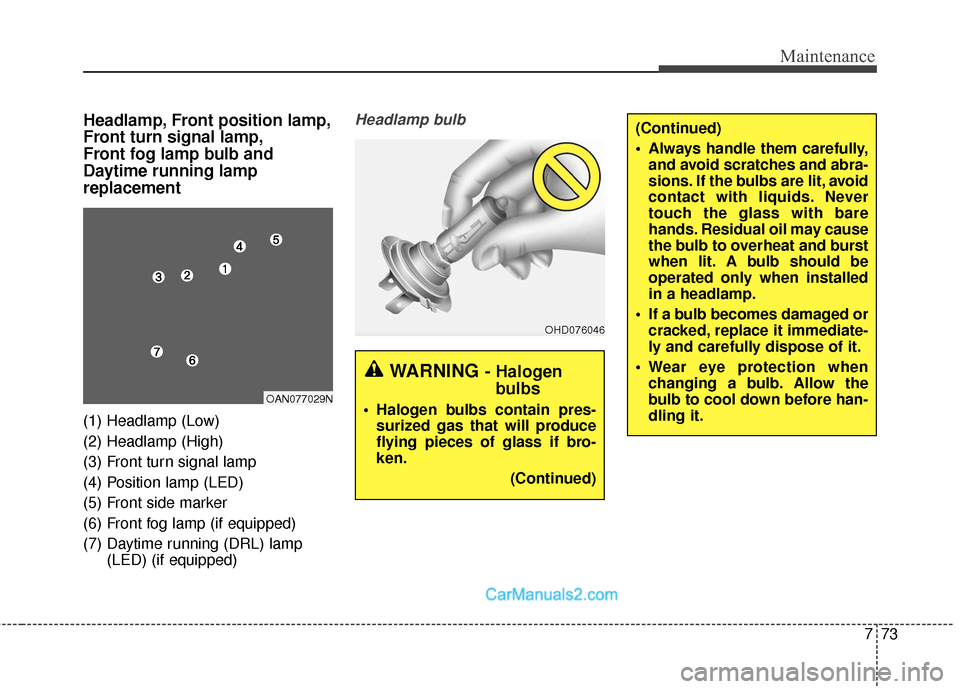
773
Maintenance
Headlamp, Front position lamp,
Front turn signal lamp,
Front fog lamp bulb and
Daytime running lamp
replacement
(1) Headlamp (Low)
(2) Headlamp (High)
(3) Front turn signal lamp
(4) Position lamp (LED)
(5) Front side marker
(6) Front fog lamp (if equipped)
(7) Daytime running (DRL) lamp(LED) (if equipped)
Headlamp bulb
OHD076046
WARNING- Halogenbulbs
Halogen bulbs contain pres-
surized gas that will produce
flying pieces of glass if bro-
ken.
(Continued)OAN077029N
(Continued)
Always handle them carefully,and avoid scratches and abra-
sions. If the bulbs are lit, avoid
contact with liquids. Never
touch the glass with bare
hands. Residual oil may cause
the bulb to overheat and burst
when lit. A bulb should be
operated only when installed
in a headlamp.
If a bulb becomes damaged or cracked, replace it immediate-
ly and carefully dispose of it.
Wear eye protection when changing a bulb. Allow the
bulb to cool down before han-
dling it.
Page 576 of 614
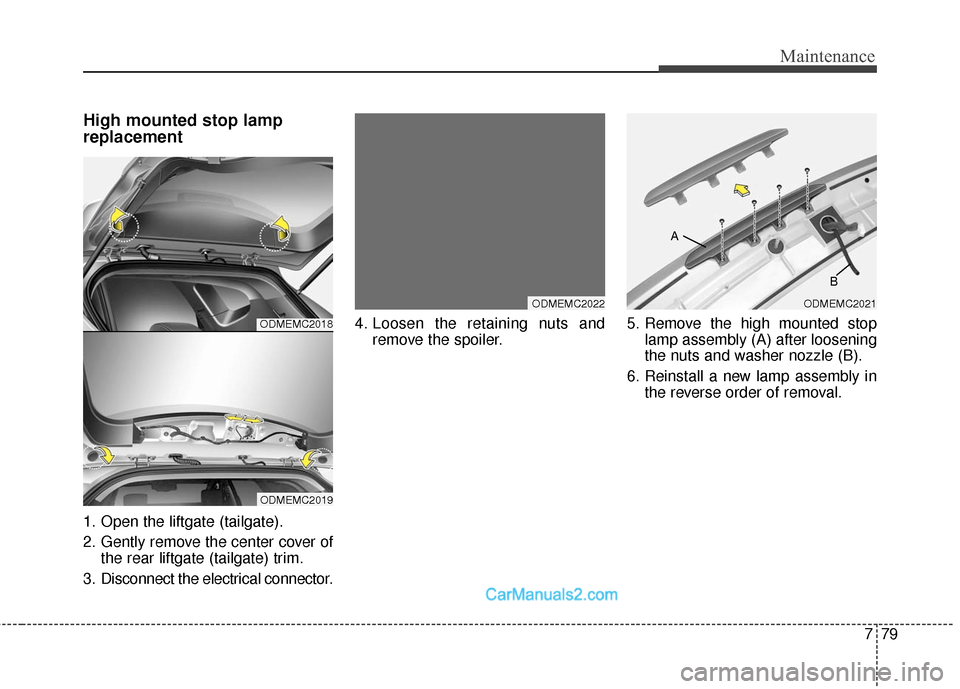
779
Maintenance
High mounted stop lamp
replacement
1. Open the liftgate (tailgate).
2. Gently remove the center cover ofthe rear liftgate (tailgate) trim.
3. Disconnect the electrical connector. 4. Loosen the retaining nuts and
remove the spoiler. 5. Remove the high mounted stop
lamp assembly (A) after loosening
the nuts and washer nozzle (B).
6. Reinstall a new lamp assembly in the reverse order of removal.
ODMEMC2022
ODMEMC2018
ODMEMC2019
ODMEMC2021
B
A
Page 580 of 614
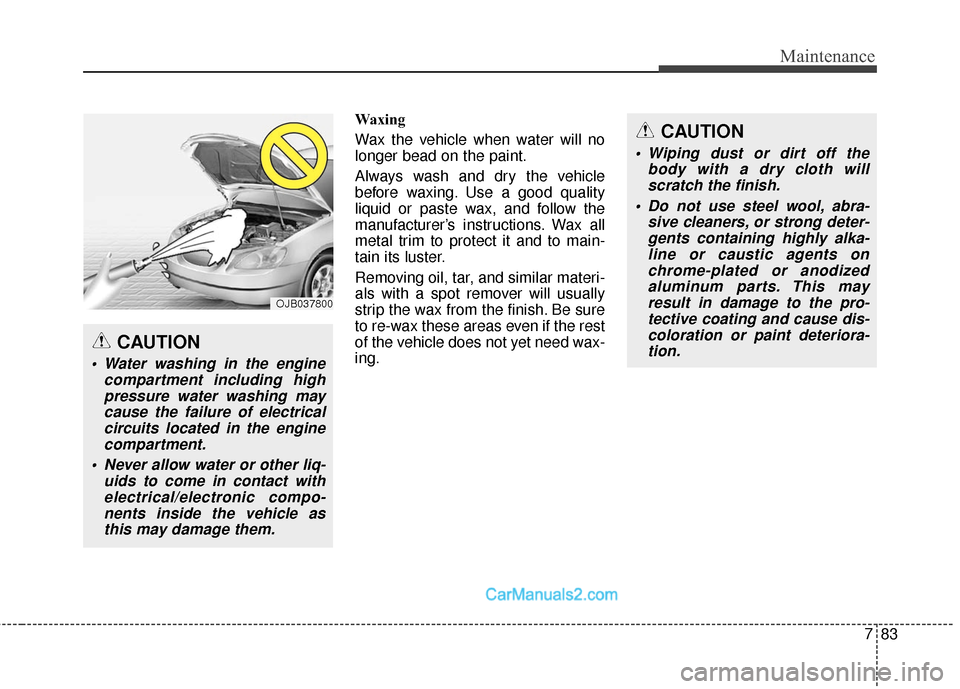
783
Maintenance
Waxing
Wax the vehicle when water will no
longer bead on the paint.
Always wash and dry the vehicle
before waxing. Use a good quality
liquid or paste wax, and follow the
manufacturer’s instructions. Wax all
metal trim to protect it and to main-
tain its luster.
Removing oil, tar, and similar materi-
als with a spot remover will usually
strip the wax from the finish. Be sure
to re-wax these areas even if the rest
of the vehicle does not yet need wax-
ing.CAUTION
Wiping dust or dirt off thebody with a dry cloth willscratch the finish.
Do not use steel wool, abra- sive cleaners, or strong deter-gents containing highly alka-line or caustic agents onchrome-plated or anodizedaluminum parts. This mayresult in damage to the pro-tective coating and cause dis-coloration or paint deteriora-tion.
CAUTION
Water washing in the engine compartment including highpressure water washing maycause the failure of electricalcircuits located in the enginecompartment.
Never allow water or other liq- uids to come in contact withelectrical/electronic compo-nents inside the vehicle asthis may damage them.
OJB037800
Page 584 of 614
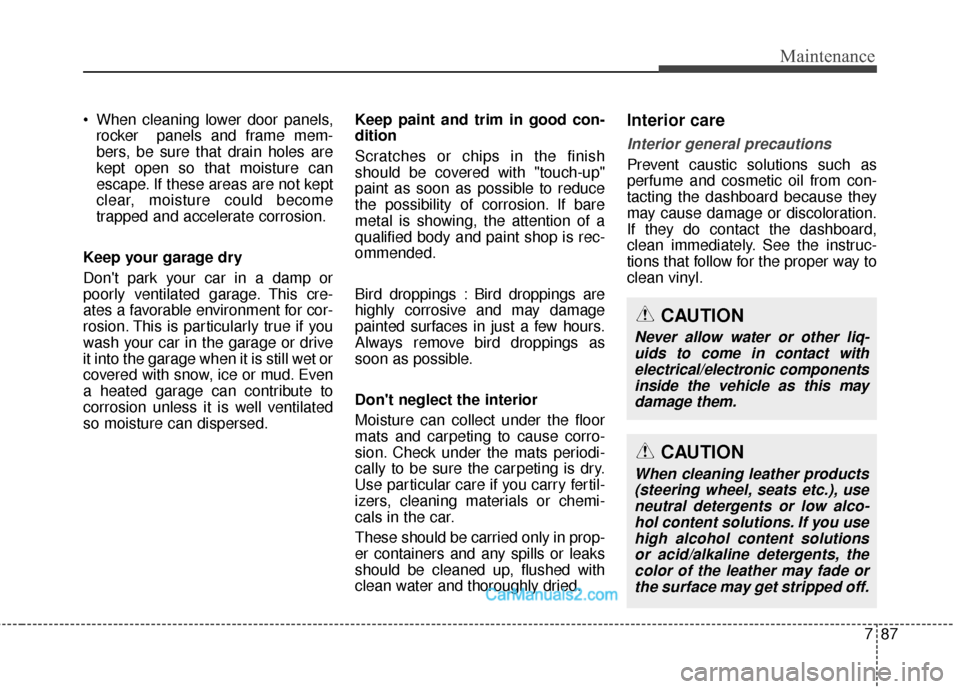
787
Maintenance
When cleaning lower door panels,rocker panels and frame mem-
bers, be sure that drain holes are
kept open so that moisture can
escape. If these areas are not kept
clear, moisture could become
trapped and accelerate corrosion.
Keep your garage dry
Don't park your car in a damp or
poorly ventilated garage. This cre-
ates a favorable environment for cor-
rosion. This is particularly true if you
wash your car in the garage or drive
it into the garage when it is still wet or
covered with snow, ice or mud. Even
a heated garage can contribute to
corrosion unless it is well ventilated
so moisture can dispersed. Keep paint and trim in good con-
dition
Scratches or chips in the finish
should be covered with "touch-up"
paint as soon as possible to reduce
the possibility of corrosion. If bare
metal is showing, the attention of a
qualified body and paint shop is rec-
ommended.
Bird droppings : Bird droppings are
highly corrosive and may damage
painted surfaces in just a few hours.
Always remove bird droppings as
soon as possible.
Don't neglect the interior
Moisture can collect under the floor
mats and carpeting to cause corro-
sion. Check under the mats periodi-
cally to be sure the carpeting is dry.
Use particular care if you carry fertil-
izers, cleaning materials or chemi-
cals in the car.
These should be carried only in prop-
er containers and any spills or leaks
should be cleaned up, flushed with
clean water and thoroughly dried.Interior care
Interior general precautions
Prevent caustic solutions such as
perfume and cosmetic oil from con-
tacting the dashboard because they
may cause damage or discoloration.
If they do contact the dashboard,
clean immediately. See the instruc-
tions that follow for the proper way to
clean vinyl.
CAUTION
Never allow water or other liq-
uids to come in contact withelectrical/electronic componentsinside the vehicle as this maydamage them.
CAUTION
When cleaning leather products(steering wheel, seats etc.), useneutral detergents or low alco-hol content solutions. If you usehigh alcohol content solutionsor acid/alkaline detergents, thecolor of the leather may fade orthe surface may get stripped off.
Page 585 of 614
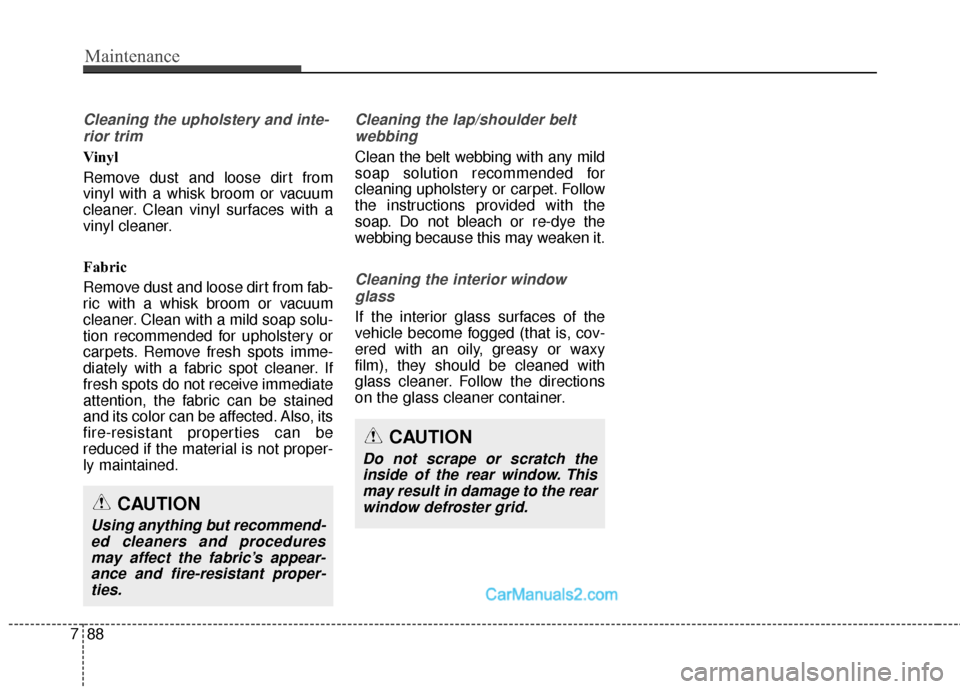
Maintenance
88
7
Cleaning the upholstery and inte-
rior trim
Vinyl
Remove dust and loose dirt from
vinyl with a whisk broom or vacuum
cleaner. Clean vinyl surfaces with a
vinyl cleaner.
Fabric
Remove dust and loose dirt from fab-
ric with a whisk broom or vacuum
cleaner. Clean with a mild soap solu-
tion recommended for upholstery or
carpets. Remove fresh spots imme-
diately with a fabric spot cleaner. If
fresh spots do not receive immediate
attention, the fabric can be stained
and its color can be affected. Also, its
fire-resistant properties can be
reduced if the material is not proper-
ly maintained.
Cleaning the lap/shoulder beltwebbing
Clean the belt webbing with any mild
soap solution recommended for
cleaning upholstery or carpet. Follow
the instructions provided with the
soap. Do not bleach or re-dye the
webbing because this may weaken it.
Cleaning the interior windowglass
If the interior glass surfaces of the
vehicle become fogged (that is, cov-
ered with an oily, greasy or waxy
film), they should be cleaned with
glass cleaner. Follow the directions
on the glass cleaner container.
CAUTION
Do not scrape or scratch theinside of the rear window. Thismay result in damage to the rearwindow defroster grid.
CAUTION
Using anything but recommend-ed cleaners and proceduresmay affect the fabric’s appear-ance and fire-resistant proper-ties.
Page 596 of 614
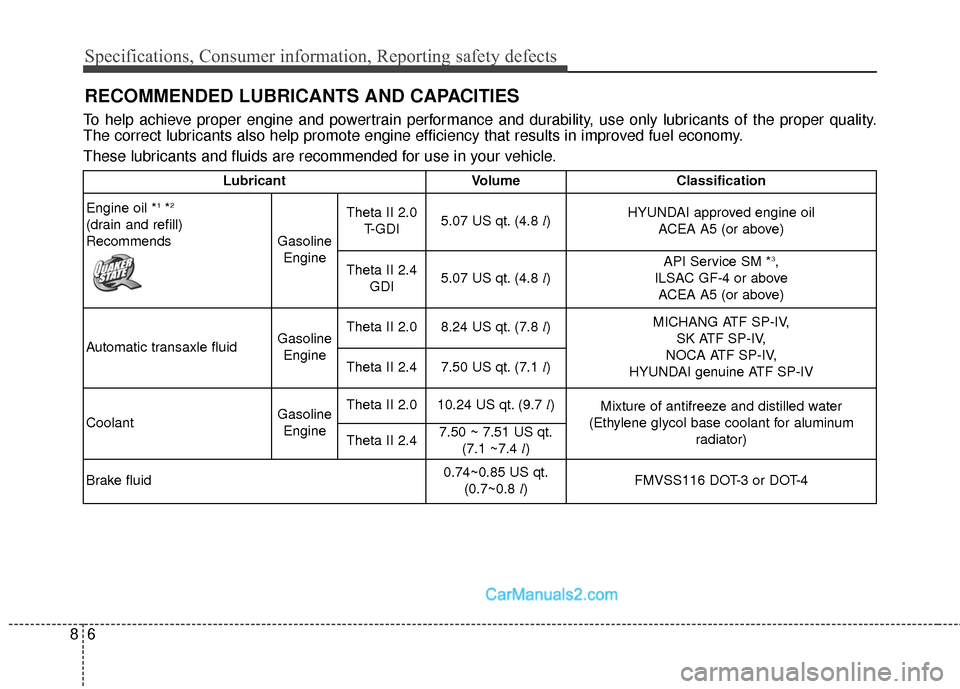
Specifications, Consumer information, Reporting safety defects
68
RECOMMENDED LUBRICANTS AND CAPACITIES
To help achieve proper engine and powertrain performance and durability, use only lubricants of the proper quality.
The correct lubricants also help promote engine efficiency that results in improved fuel economy.
These lubricants and fluids are recommended for use in your vehicle.
LubricantVolumeClassification
Engine oil *
1*2
(drain and refill)
Recommends Gasoline EngineTheta II 2.0
T-GDI 5.07 US qt. (4.8
l)HYUNDAI approved engine oil
ACEA A5 (or above)
Theta II 2.4 GDI 5.07 US qt. (4.8
l) API Service SM *
3,
ILSAC GF-4 or above ACEA A5 (or above)
Automatic transaxle fluid Gasoline
Engine Theta II 2.0
8.24 US qt. (7.8
l) MICHANG ATF SP-IV,
SK ATF SP-IV,
NOCA ATF SP-IV,
HYUNDAI genuine ATF SP-IV
Theta II 2.4
7.50 US qt. (7.1
l)
Coolant Gasoline
Engine Theta II 2.0
10.24 US qt. (9.7
l)
Mixture of antifreeze and distilled water
(Ethylene glycol base coolant for aluminum radiator)
Theta II 2.4 7.50 ~ 7.51 US qt.
(7.1 ~7.4 l)
Brake fluid 0.74~0.85 US qt.
(0.7~0.8 l) FMVSS116 DOT-3 or DOT-4
Page 597 of 614
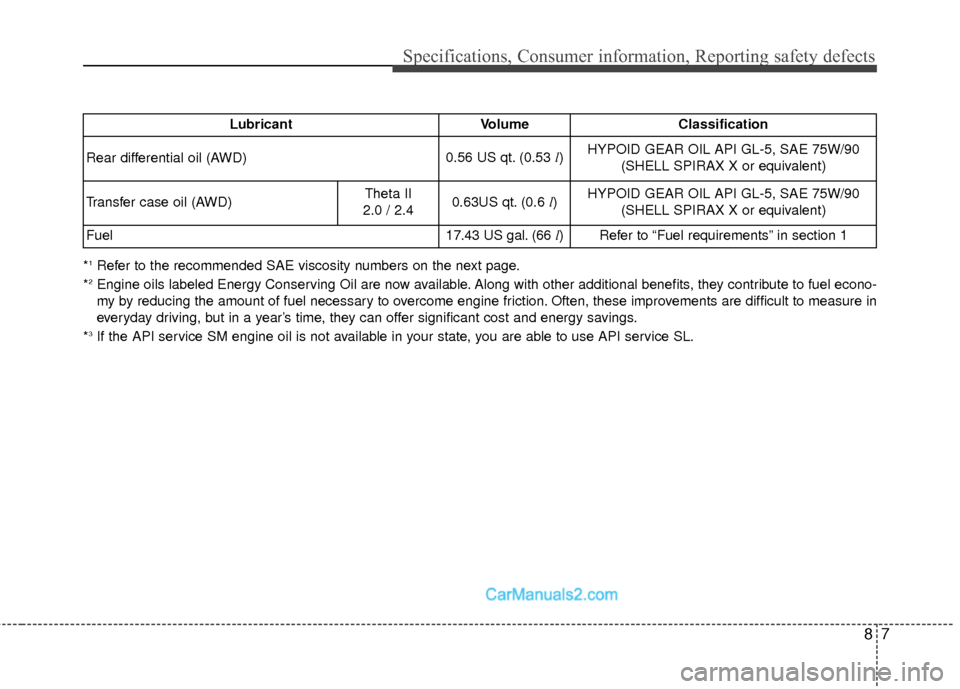
87
Specifications, Consumer information, Reporting safety defects
*1Refer to the recommended SAE viscosity numbers on the next page.
*2Engine oils labeled Energy Conserving Oil are now available. Along with other additional benefits, they contribute to fuel econo -
my by reducing the amount of fuel necessary to overcome engine friction. Often, these improvements are difficult to measure in
everyday driving, but in a year’s time, they can offer significant cost and energy savings.
*
3If the API service SM engine oil is not available in your state, you are able to use API service SL. Lubricant Volume Classification
Rear differential oil (AWD) 0.56 US qt. (0.53
l)HYPOID GEAR OIL API GL-5, SAE 75W/90
(SHELL SPIRAX X or equivalent)
Transfer case oil (AWD) Theta II
2.0 / 2.4 0.63US qt. (0.6 l)
HYPOID GEAR OIL API GL-5, SAE 75W/90
(SHELL SPIRAX X or equivalent)
Fuel 17.43 US gal. (66
l)
Refer to “Fuel requirements” in section 1
Page 598 of 614
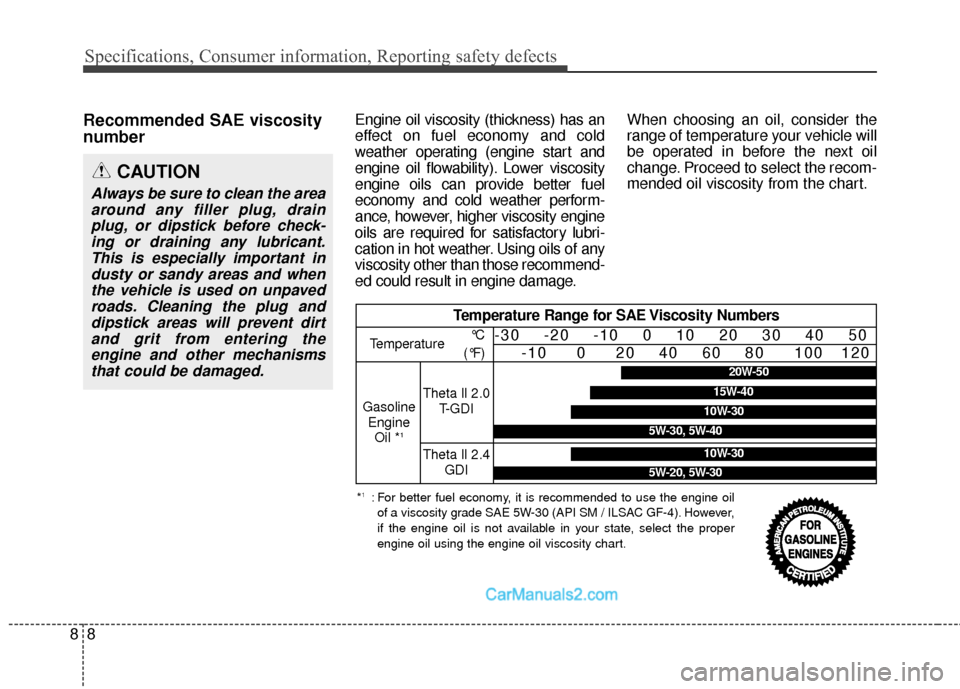
Specifications, Consumer information, Reporting safety defects
88
Recommended SAE viscosity
number Engine oil viscosity (thickness) has an
effect on fuel economy and cold
weather operating (engine start and
engine oil flowability). Lower viscosity
engine oils can provide better fuel
economy and cold weather perform-
ance, however, higher viscosity engine
oils are required for satisfactory lubri-
cation in hot weather. Using oils of any
viscosity other than those recommend-
ed could result in engine damage.When choosing an oil, consider the
range of temperature your vehicle will
be operated in before the next oil
change. Proceed to select the recom-
mended oil viscosity from the chart.
CAUTION
Always be sure to clean the area
around any filler plug, drainplug, or dipstick before check-ing or draining any lubricant.This is especially important industy or sandy areas and whenthe vehicle is used on unpavedroads. Cleaning the plug anddipstick areas will prevent dirtand grit from entering theengine and other mechanismsthat could be damaged.
*1: For better fuel economy, it is recommended to use the engine oil
of a viscosity grade SAE 5W-30 (API SM / ILSAC GF-4). However,
if the engine oil is not available in your state, select the proper
engine oil using the engine oil viscosity chart.
Temperature Range for SAE Viscosity Numbers
Temperature
Theta ll 2.0T-GDI
Gasoline
Engine Oil *
1
°C
(°F)-30 -20 -10 0 10 20 30 40 50 -10 0 20 40 60 80 100 120
Theta ll 2.4GDI10W-30
5W-20, 5W-30
20W-50
10W-30
15W-40
5W-30, 5W-40
Page 607 of 614
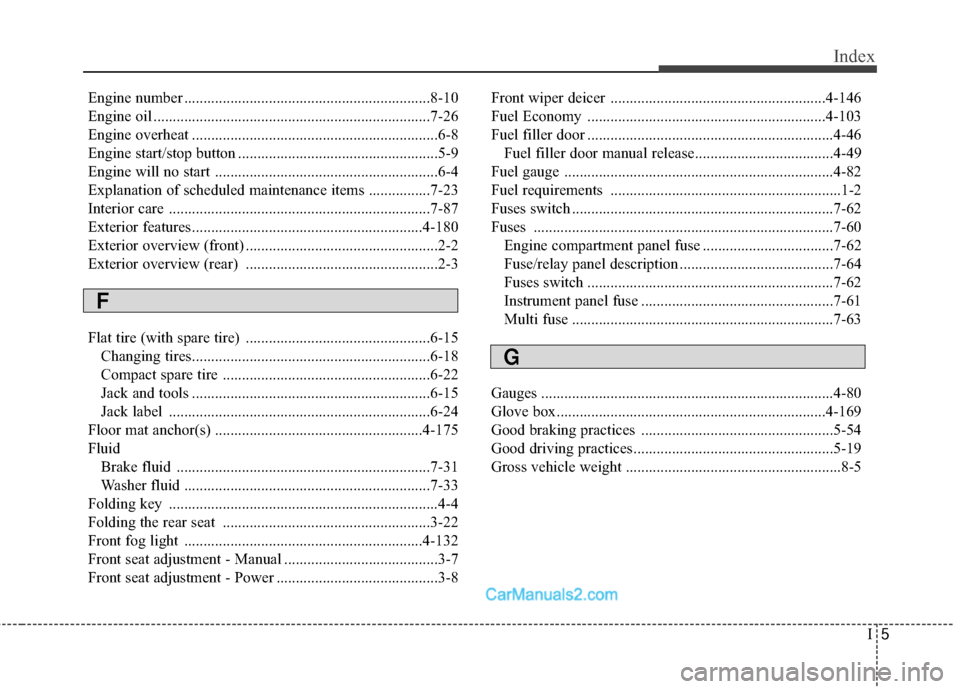
I5
Index
Engine number ................................................................8-10
Engine oil ........................................................................\
7-26
Engine overheat ................................................................6-8
Engine start/stop button ....................................................5-9
Engine will no start ..........................................................6-4
Explanation of scheduled maintenance items ................7-23
Interior care ....................................................................7-87\
Exterior features............................................................4-180
Exterior overview (front) ..................................................2-2
Exterior overview (rear) ..................................................2-3
Flat tire (with spare tire) ................................................6-15Changing tires..............................................................6-18
Compact spare tire ......................................................6-22
Jack and tools ..............................................................6-15
Jack label ....................................................................6-24\
Floor mat anchor(s) ......................................................4-175
Fluid Brake fluid ..................................................................7-31
Washer fluid ................................................................7-33
Folding key ......................................................................4-\
4
Folding the rear seat ......................................................3-22
Front fog light ..............................................................4-132
Front seat adjustment - Manual ........................................3-7
Front seat adjustment - Power ..........................................3-8 Front wiper deicer ........................................................4-146
Fuel Economy ..............................................................4-103
Fuel filler door ................................................................4-46
Fuel filler door manual release....................................4-49
Fuel gauge ......................................................................4-\
82
Fuel requirements ............................................................1-2
Fuses switch ....................................................................7-62\
Fuses ........................................................................\
......7-60 Engine compartment panel fuse ..................................7-62
Fuse/relay panel description ........................................7-64
Fuses switch ................................................................7-62
Instrument panel fuse ..................................................7-61
Multi fuse ....................................................................7-63\
Gauges ........................................................................\
....4-80
Glove box......................................................................4-\
169
Good braking practices ..................................................5-54
Good driving practices....................................................5-19
Gross vehicle weight ........................................................8-5
F
G
Page 611 of 614
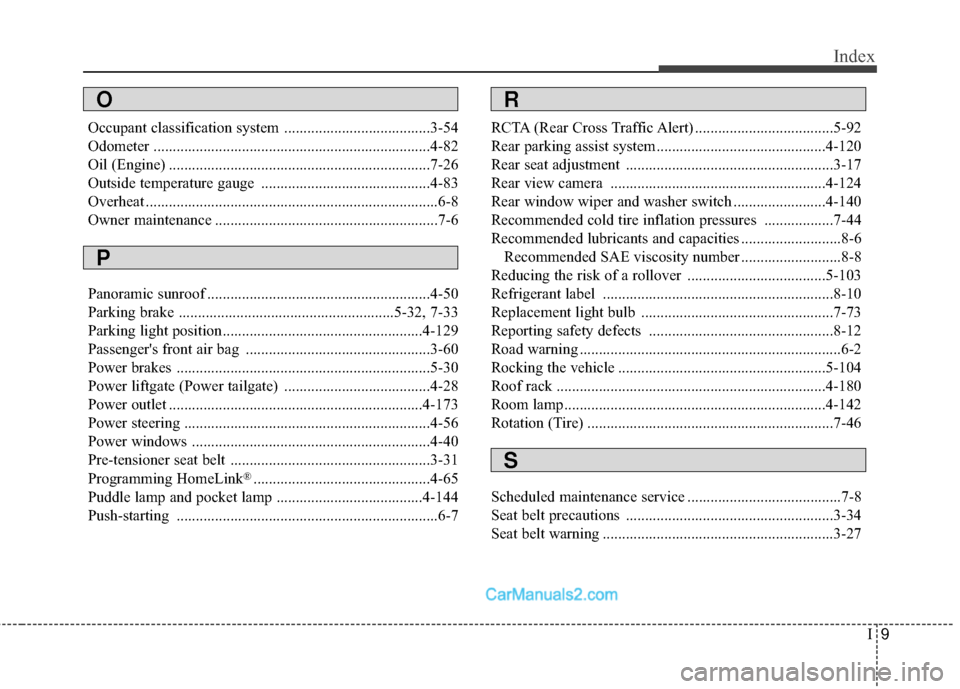
I9
Index
Occupant classification system ......................................3-54
Odometer ........................................................................\
4-82
Oil (Engine) ....................................................................7-26\
Outside temperature gauge ............................................4-83
Overheat ........................................................................\
....6-8
Owner maintenance ..........................................................7-6
Panoramic sunroof ..........................................................4-50
Parking brake ........................................................5-32, 7-33
Parking light position....................................................4-129
Passenger's front air bag ................................................3-60
Power brakes ..................................................................5-30
Power liftgate (Power tailgate) ......................................4-28
Power outlet ..................................................................4-173
Power steering ................................................................4-56
Power windows ..............................................................4-40
Pre-tensioner seat belt ....................................................3-31
Programming HomeLink
®..............................................4-65
Puddle lamp and pocket lamp ......................................4-144
Push-starting ....................................................................6-7 RCTA (Rear Cross Traffic Alert) ....................................5-92
Rear parking assist system............................................4-120
Rear seat adjustment ......................................................3-17
Rear view camera ........................................................4-124
Rear window wiper and washer switch ........................4-140
Recommended cold tire inflation pressures ..................7-44
Recommended lubricants and capacities ..........................8-6
Recommended SAE viscosity number ..........................8-8
Reducing the risk of a rollover ....................................5-103
Refrigerant label ............................................................8-10
Replacement light bulb ..................................................7-73
Reporting safety defects ................................................8-12
Road warning ....................................................................6-2
Rocking the vehicle ......................................................5-104
Roof rack ......................................................................4-\
180
Room lamp....................................................................4-14\
2
Rotation (Tire) ................................................................7-46
Scheduled maintenance service ........................................7-8
Seat belt precautions ......................................................3-34
Seat belt warning ............................................................3-27
O
P
R
S